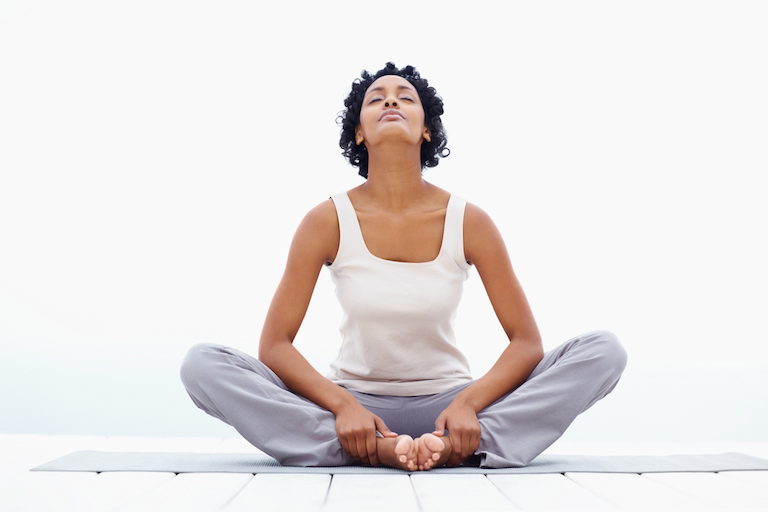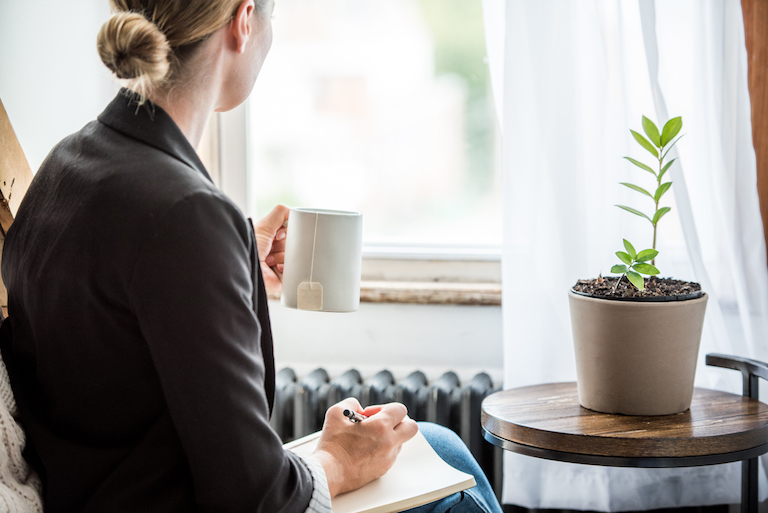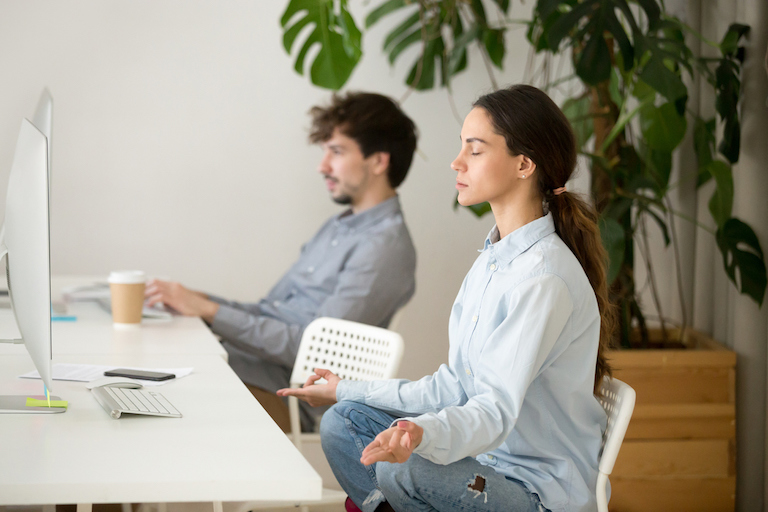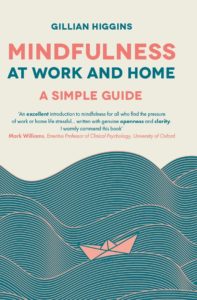Being calm at work was essential for barrister Gillian Higgins who has analysed genocides, war crimes and gang members – here’s her mindfulness guide
As an international criminal lawyer, I have represented heads of state, former presidents, military leaders and politicians. In the process, I’ve analysed corridors of evidence of war crimes, crimes against humanity and genocide. Working on cases involving the genocide in Rwanda, the Balkan wars and post-election violence in Kenya has been a unique experience, but it has also involved prolonged periods of stress, which have periodically spilled over into my private life.
I’ve analysed genocide in Rwanda, the Balkan wars and violence in Kenya and it has been a unique experience, but has also involved prolonged periods of stress
It was, however, the prospect of becoming a mother to my adopted daughter five years ago that made me pause and consider how to deal with my accumulated stress and how to be present as a parent. I wanted to be able to respond more sensitively to situations at work and home.
I wasn’t sure how to bring about these changes but I knew from my limited experience of meditation some years ago, that it had helped me to feel a sense of calm. Over the past few years, interest in mindfulness had grown significantly and I was keen to learn more. I joined a local class, read as many books as I could and practised at home, even when I didn’t want to.
After a few months, I started to feel a subtle difference. At work I became more able to cope with stressful situations, less reactively. I interpreted the outcomes of difficult conversations less personally and found rejection and disappointment somehow easier to handle.
It was hard to explain this to others, but I felt slight positive shifts in my ability to manage people and difficult conversations. It even made my commute to London more manageable as it became a time of practice, rather than a source of irritation.
I felt slight positive shifts in my ability to manage people and difficult conversations
The benefits were real. I managed to avoid or stop arguments at home by becoming aware of the tone of my voice – and changing it slightly. I paused and breathed deeply before responding to the inexplicable rage of my young daughter. I became aware of the physical rising of my own anger and frustration when things went wrong. I discerned more readily when to rest rather than ‘push on through’ and became more compassionate towards myself when I didn’t live up to my own high expectations.
As a new parent, I got better at carving out much-needed breathing space and enjoying the moment, whatever it ended up looking like. I was able to drop, or at least amend, unrealistic expectations of how it was to raise a child. I used mindfulness to bring a moment of calm to the busyness of the school run, the chaos of play dates and the challenge of connecting with new parents without judgment.
It will help you spot your mind being hijacked by an overwhelming emotion
I realised that I could choose to breathe and refrain from losing my temper when my daughter threw yet another tantrum, and saw the wisdom of bringing her in close.
While I didn’t necessarily become visibly calmer, I began to recognise when I was at risk of being hijacked by an overwhelming emotion. Practising mindfulness empowered me to pause long enough to decide whether to be washed away by the emotion or allow it to wash over me, knowing that it would move on, if I let it.

It’s all about paying attention to moments of everyday life with curiosity and openness, on purpose. It involves dropping into our present moment experience and being aware of what we’re doing, while we’re doing it, with a non-judgmental attitude. It sounds easy, but increasingly it’s hard to find the time to pause and take stock. Mindfulness invites us to experience the ‘here and now’, rather than hankering after how we would like life to be.
Research shows that our minds wander 46.9 per cent of the time, and that a wandering mind is for the most part, an unhappy one. We may find ourselves staggering around our mental ‘To Do’ list trying to remember to feed the cat, call home, send a memo, confront a colleague and somehow lose weight – on a daily basis.
You will witness the essence of the moment with all its wrinkles and cracks
The fact that our brains are burdened by a negativity bias doesn’t help as it means that we tend to remember the bad, the difficult and the ugly.
When we practise mindfulness, we’re encouraged to witness the essence of the moment, just as it is, -with all its wrinkles and cracks…so that we don’t miss out on what’s actually going on, in our quest for some hallowed life elsewhere. So how can it help us at work and what difference could it make?

You can do mindfulness meditation
One way is to learn mindfulness meditation, by using a point of focus, such as the passage of your breath. When your mind gets distracted and wanders off into thinking, worrying, or planning, simply notice where it has wandered to and gently guide it back to following the physical sensation of the in-breath and the out-breath. Do this every time the mind wanders – with kindness to yourself. With practice, you recognise that thoughts are not facts and will come and go of their own accord, if you allow them to do so.
But you don’t have to meditate – daily mindfulness as you go about your day works too
Another way is to use ‘daily mindfulness practices’. These are instances during the day where you pause, breathe and bring moment-to-moment awareness to something as simple as the brewing of your tea or the taking of your morning shower. By pausing and staying present with the moment, you might notice the aroma of your drink or the sensation of the water as you take in your experience fully. So often, the uniqueness of the moment is lost as our focus shifts to simply getting through the day – or out the front door.
Over time it will help you handle stress better
Mindfulness is good for us as it takes us out of stress mode (‘fight-flight-freeze’) and engages what’s known as our parasympathetic nervous system (‘rest and digest’). This reduces harmful levels of stress hormones released into the body when the fight-flight-freeze response is activated.
Engaging this half of the nervous system is a reliable way of regulating the impact of negative stress. Knowing that we can ‘rest and digest’ at any moment during the day by practicing mindfulness encourages us to take breaks, breathe deeply and look after our needs – as well as those of others.
In my work as a war crimes barrister, it has helped me to handle the narratives of witnesses I hear in court. Just as the practice teaches us how to allow thoughts to pass, we learn to apply the same approach to difficult or troubling things we see or hear that may otherwise disturb our peace of mind and ability to focus.
It could help you understand other people better
In this way, we reduce the chance of being hijacked by strong emotions or negative thoughts. As a mediator, mindfulness has helped me to refrain from pre-judging individuals who find themselves in difficult, emotional conflict.I felt slight positive shifts in my ability to manage people and difficult conversations.
I have practiced mindfulness in meetings, courtrooms, the office, at home and during my commute. I use mindfulness at different times throughout the day – when the train is late, when I forget to hit save on a document or when an angry email lands in my inbox. It can be practised anywhere, by anyone at any time of the day or night.
It will help you repair situations when things go wrong

Mindfulness grows our self-awareness, which gives us a better sense of what’s actually going on and reminds us that we can choose how to respond, rather than simply react out of habit. We become more aware of what we need to do to look after ourselves – whether it’s more sleep, time alone, or taking a walk with a friend.
It will help you navigate arguments
Personally, it reminds me to schedule time between cases, ring-fence family events, consider my own levels of tiredness and plan accordingly. A weekend of doing ‘nothing’ is sometimes just what’s needed, where everyone can tinker, potter, play and simply be. The practice has helped me to navigate family arguments, listen and respond to complaints in meetings and decide whether or not to have a difficult conversation or to simply ‘let it go’. It helps me to step back, give the benefit of the doubt and apologise when I’m wrong. It has gently infiltrated my daily life.
This doesn’t mean however that I no longer get angry or lose my temper. Rather, it gives me the pause I need to work out how I should respond. This moment of reflection can mean the difference between an angry row and a robust exchange of views.
It will help you tame your inner critical voice
The bald truth is that we all have one, whether we like it or not. The inner critical voice is perhaps best described as the familiar negative tune the mind starts to hum to remind us of how inadequate it deems us to be.
It’s the voice of disgust or disappointment that appears almost audibly like a soundtrack on repeat. It’s the judgmental way we speak to ourselves in a tone we would never use with a friend. We live alongside it and end up depleted or exhausted by its content. It is often a symptom of stress or exhaustion.
In the workplace, the critical voice might try to convince us that we’re not popular or that we will never attain the professional heights we seek. It might whisper to us that ‘life is elsewhere’ or that we’re simply not good enough. Some people view it as a necessary evil to drive them on to achieve better results, but in reality, it serves only to reinforce a sense of unworthiness and impacts our ability to make rational decisions.
…but also to listen to it
The first step is to notice its arrival, which is easier said than done as we rarely question its existence. This is where the practice of mindfulness can help. Rather than automatically believing its content, we begin to recognise that our inner critic may be unhelpful, hurtful or even inhibit our progress if we pay too much attention to it. The practice helps us to develop a greater awareness of what we tell ourselves and whether or not it’s true – or fair.
So, the next time your inner critical voice appears, whether it’s at work or home, see if you can hear what it says, notice how often it visits and how it makes you feel. You might want to label it in some way, such as ‘negative voice telling me I’m not good enough’ or ‘self-defeating voice of doom before I’ve even started.’
In response, choose to acknowledge its presence and gently invite it to leave. Noticing how vicious your own commentary can be often provides a much needed moment for reflection. Ultimately, by befriending your mind and understanding its habits, you become less vulnerable to its impact and less prone to being trampled by the demands of your own perfectionism.
3 ways to practice mindfulness at work
1. The mindful pause

It’s not a moment of no activity, or an immediate escape from the chaos that may surround you. Rather, it’s an intentional interruption to the flow of what you’re doing, wherever you are. It allows you to step outside your train of thought and take a break from demands. For me, it’s a game-changer as a mini-practice that can help to relieve stress and reduce tension.
The practice
To introduce a mindful pause into your working day, choose a time when you will not be disturbed for just a few minutes. It might be when you first arrive at work, at lunchtime or just before you leave. Simply lower your gaze or close your eyes and tune in to the passage of your breath.
When your mind starts to wander into planning, worrying or thinking mode, notice where it wanders to and then gently guide it back to the breath. Do this every time it wanders. Practise for just a few moments, at intervals during the day, whenever you feel the need to de-stress or take time out for yourself.
2. The mindful commute

I am fascinated by the extent to which people use their electronic devices when commuting. My train research shows that eight out of ten of those who commute on my journey into London are ‘attached to distraction’, with some being attached to more than one device at once! While some people use a device to catch up on work, others are merely scrolling or zoning out. So how could you spend this time more mindfully if you’re one of the many thousands who commute to work on a daily basis?
The practice
Choose to give yourself a break from attachment to distraction by seeing if for at least five or ten minutes you can turn off your phone, iPad, laptop – and simply be. Close your eyes or lower your gaze. Let go of any thoughts that arise and return to your breath, using it as your anchor or point of focus. Now start to direct your attention to different parts of your body.
Perhaps start with your feet and slowly move to the top of your head – taking in your whole body breathing. Notice any sensations that arise. You might feel a sense of warmth, a tingling, an ache or nothing at all. After a few minutes, open your eyes. See how you feel after this short period of letting go.
3. Mindful meetings

The Practice
As you walk to the meeting venue, take a few deep breaths and slow your pace. Take your time to arrive. Once in the meeting room, see how it feels to stay silent for the first few moments, letting everyone arrive physically and mentally. Take in your surroundings and notice how you’re sitting. Relax your shoulders and perhaps adopt the hint of a smile. Notice your body language and that of others. See if you can truly listen and consider how you engage. Return to following your natural breath at intervals during the meeting. Notice how you feel.
Extracts have been taken from Mindfulness at Work and Home by Gillian Higgins, published on 19th September 2019.
Gillian Higgins is an international criminal barrister, mediator and mindfulness teacher at The Chambers of 9 Bedford Row in London. She is also the founder of Practical Meditation.
Gillian hosts seminars, courses and workshops on mindfulness to individuals and organisations.
Gillian’s first book “Mindfulness at Work and Home” is published by RedDoor Press and is available at www.practicalmeditation.co.uk.
It is also available at Waterstones, Foyles and other bookshops online worldwide.
Relevant Healthista content:
4 ways stress is showing on your skin and exactly how to cope
How to relieve stress with hand reflexology
Mindfulness and running – the therapy that could change your life
7 best natural candles to help you relax
Other Healthista content you might like:
Tired All the Time? 7 signs you need an energy makeover
Menopause symptoms? Here’s how these celebs dealt with theirs
7 ways walking can boost creativity – proven by science
3 breathing techniques this Instagram super yogi swears by
Like this article? Sign up to our newsletter to get more articles like this delivered straight to your inbox.























































